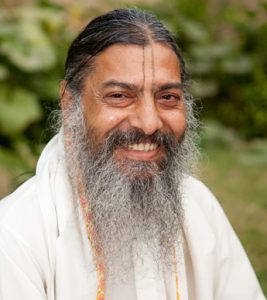Tattva Sandarbha: Vaisnava Epistemology and Ontology
Of the Six Sandarbhas, Tattva Sandarbha is the smallest in size, but not in importance. As its name suggests, it discusses the Reality (tattva) that is the ultimate subject to be understood and realized. Tattva also means “essence,” and thus Tattva Sandarbha provides the essence of what is to be elaborated upon in the rest of the Sandarbhas. Thus, it serves as an introduction to them.
It may be said that Tattva Sandarbha lays the foundation for entry into the subject matter of Bhāgavata Purāṇa, a detailed analysis of which follows in the rest of the Sandarbhas. It does so particularly by providing the epistemological viewing frame through which Bhagavān is directly intuited, devotionally served, and established ultimately as the supreme object of divine love.
PARAMATMA SANDARBHA: The Living Being, Its Bondage and The Immanent Absolute
Paramātma Sandarbha is the third book in the series of six treatises called Ṣaṭ Sandarbhas or Bhāgavata Sandarbha. It is an elaborate essay on the nature of Paramātmā. The distinction between Absolute Reality’s manifestations as Paramātmā and Bhagavān is relatively unknown, even to specialists in the field of Vedānta. These two specific designations are often used synonymously to refer to a single aspect of the tattva. It was Śrī Jīva Gosvāmī’s genius to clearly define them and enumerate their characteristics and functions in detail. There is no other work in the entire gamut of Indian theological and philosophical literature that throws light on this subject so lucidly.
BHAGAVAT SANDARBHA: God — His Qualities, Abode and Associates
The second book of Śrīla Jīva Gosvāmī’s Ṣaṭ Sandarbhas, is quite simply a book about Bhagavan, or God, the Supreme Being. To avoid narrow and misleading notions, Śrīla Jīva Gosvāmī first establishes an objective and far-reaching context in which Bhagavan can be self-evidently understood, free from constrictive or reductionist interpretations. In striking opposition to popular spiritual ideas, such as “All is One,” he supplies the reader with knowledge of Ultimate Reality with unparalleled precision and exacting detail.
This Reality, which is described as Nondual Consciousness (advaya-jñāna), is realized in three aspects: as Brahman (God without any qualities, the Unqualified Absolute), as Paramatma (the Immanent Self residing in each of us), and as Bhagavan (the all-powerfull, all-blissful, infinitely charming playful Person). Śrīla Jīva Gosvāmī analyzes each of these aspects and demonstrates with conclusive evidence that Bhagavan is the complete and indivisible Absolute Reality and that all other manifestations are dependent on, and thus subordinate to, Him.
Kṛṣṇa Sandarbha: The Original Form of God
Sanskrit Text with English Translation and Jīva-toṣaṇī Commentary by SATYANARAYANA DASA
Within the entire gamut of Vedic literature, Śrī Kṛṣṇa Sandarbha stands out as a unique and brilliant investigation into the constitutional being of Svayaṁ Bhagavān. Who or what Bhagavān actually is in His own identity is not at all clear to people in general and also to the majority of spiritual practitioners. Prior to discussing Bhagavān in general in Bhagavat Sandarbha and Svayaṁ Bhagavān in particular in this fourth volume, Śrī Jīva Gosvāmī laid the foundation for an existentially grounded inquiry in the first volume itself, by making evident the primordial and fundamental nature of the Reality (tattva) to be investigated. After first defining Reality as nondual consciousness with reference to the famous vadanti verse (SB 1.2.11), he proceeded to explain how the One Nondual Absolute is self-disclosed as Bhagavān to the devotees, as the Immanent Self, Paramātmā, to the yogīs, and as unqualified Brahman to the jñānīs. Establishing Kṛṣṇa as Svayaṁ Bhagavān is the principal theme of Kṛṣṇa Sandarbha. This is also one of the chief distinctive features of the Gauḍīya School of Vaiṣṇavism. Although it contravenes the popular belief of Hindu indologists, this understanding is crucial for the highest type of devotion, uttama-bhakti, known as rāgānugā. Śrī Jīva Gosvāmī thus endeavors to dispel any doubts in this regard. This is his unique contribution to Hindu theology.
Download samples and more information on sandarbhas.jiva.org.
Author: Śrīla Jīva Gosvāmī
Translator / Commentator: Satyanarayana Dasa
Satyanarayana Dasa, born in 1954, was drawn to the spiritual traditions of his home country India since his childhood. After receiving a postgraduate degree in 1978 from IIT Delhi and working in the United States for four years, he returned to India. There he studied the formal systems of Indian philosophy known as Ṣaḍ-darśana under the direct guidance of his guru Śrī Haridāsa Śāstrī Mahārāja and Swami Syama Saraṇa Maharaja.
This education was taken up in the traditional manner for more than 25 years, while he dedicated himself as a practitioner of bhakti yoga. In 1991 he accepted the traditional Vaiṣṇava order of renounced life, bābājī-veṣa. His main focus has been with the works of Śrīla Jīva Gosvāmī, particularly on translating the Ṣaṭ Sandarbhas, into English and commenting on them. He also earned four śāstric degrees, and received both a law degree and a PhD in Sanskrit from Agra University.
Satyanarayana Dasa is the director of the Jiva Institute of Vaishnava Studies in Vrindavan, India. He is a visiting professor at Rutgers, the State University of New Jersey. In 2013 he was honored by the president of India, Pranab Mukherjee, for his extraordinary contribution in presenting Vedic culture and philosophy, both nationally and internationally.
Bhakti Sandarbha

Happiness which comes from sense contact is the very thing which brings you suffering. If you analyze all of your suffering, you will find the root cause is some material pleasure. There is no material enjoyment that will not lead to suffering. But because of the time gap, we don’t put two plus two together. So we don’t realize the connection between suffering and enjoyment. If anything has given you happiness, also know that it is going to give you trouble.
info@german.jiva.org for inquiries about Jiva Institute and guesthouse bookings
For website question please use our contact-form»
380 Sheetal Chaya
Raman Reti, Vrindavan
UP 281121, India
© 2017 JIVA.ORG. All rights reserved.
